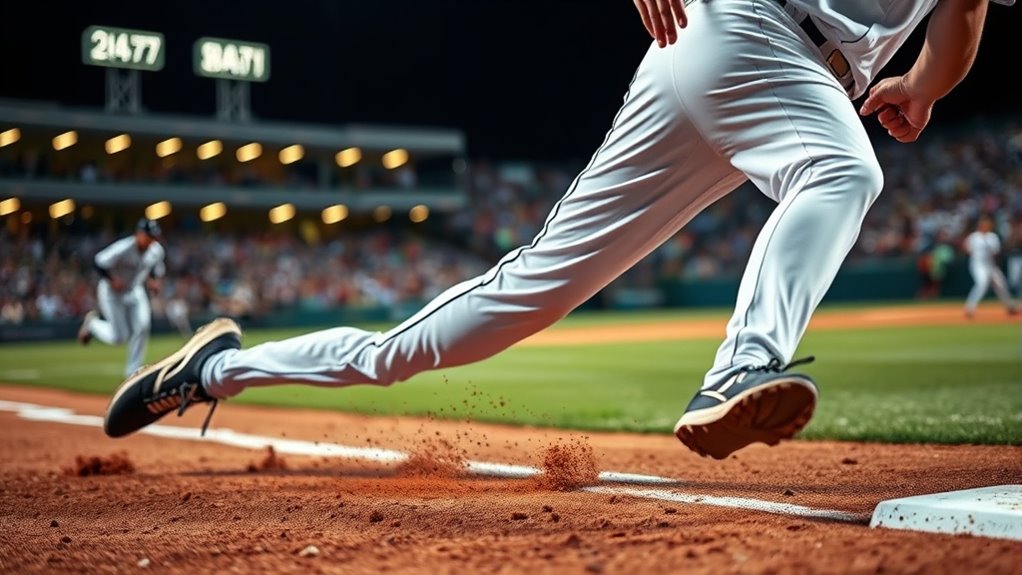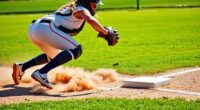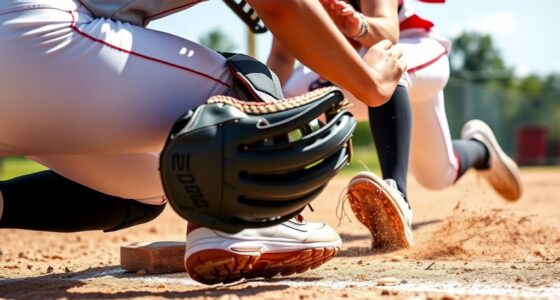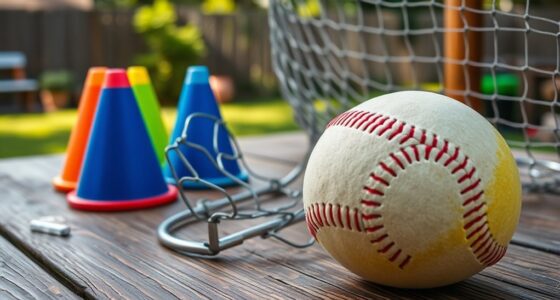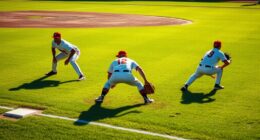To take extra bases smartly, focus on proper sliding techniques and decision-making. Use quick, controlled slides that stay low and target the back corner of the base to avoid tags. Decide when to slide or keep running based on the ball’s position, your speed, and how close the play is. Master different slides like feet-first or head-first for safety and speed. Keep control, improve timing, and you’ll become a smarter base runner—discover more tips as you continue.
Key Takeaways
- Use proper sliding techniques to improve safety, control, and success when taking extra bases.
- Decide when to slide or keep running based on ball position, play timing, and risk assessment.
- Choose between feet-first and head-first slides to match the situation and maximize safety.
- Maintain correct body position and timing to avoid injuries and increase the chances of reaching the base safely.
- Practice consistently to develop muscle memory, ensuring smooth, confident, and smart sliding during games.
Understanding the Importance of Smart Sliding Techniques
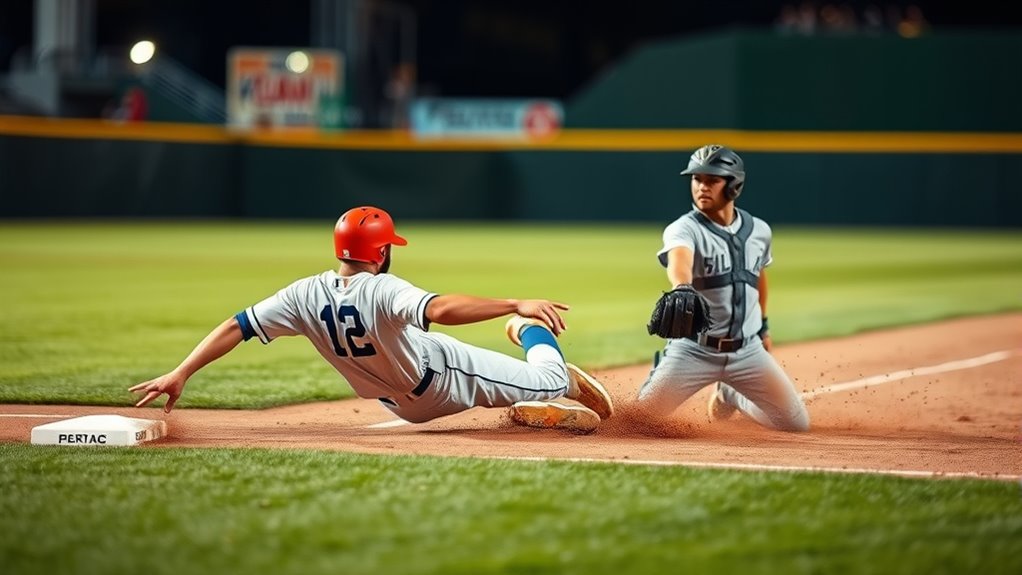
While sliding might seem straightforward, using smart sliding techniques can substantially improve your chances of safely advancing on the bases. Prioritizing slide safety is essential to prevent injuries and avoid costly mistakes. Proper sliding drills help you develop control, balance, and confidence. Focus on staying low and aiming for the back corner of the base to avoid tags. Keep your hands close to your body and slide feet-first or head-first based on the situation. Practicing these drills regularly builds muscle memory, making your slides smoother and safer during games. Remember, the goal is to reach the base quickly without risking injury or interference. Smart sliding techniques are key to becoming a more effective and safe base runner. Understanding the importance of technique can help you improve your overall performance and safety on the bases.
When to Decide to Slide or Keep Running
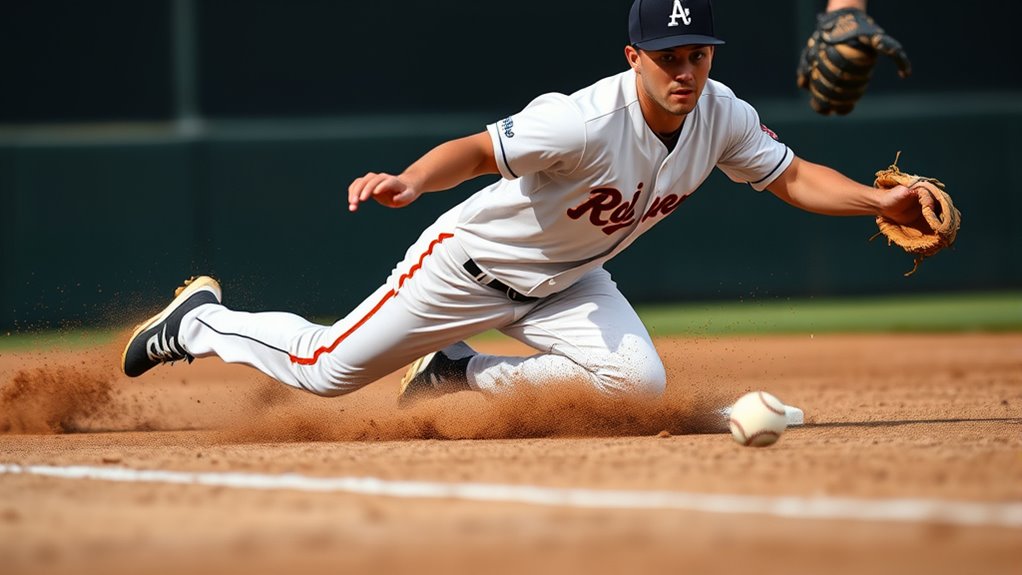
Deciding whether to slide or keep running depends on the situation at the moment you reach the base. Your slide decision should be based on a quick risk assessment. Consider the position of the ball, the baseman’s throw, and your speed. If the baseman is in control and the throw is accurate, sliding can give you a better chance to avoid a tag. But if the play is close and the ball is coming late, keeping your momentum might be smarter to avoid losing speed. Also, assess whether sliding could cause injury or if it’s unnecessary in a safe, clear path. Ultimately, your instinct and quick judgment will determine whether a slide or a keep-running approach is best in that moment. Incorporating digital literacy into training can help players analyze game scenarios more effectively.
Different Types of Slides and When to Use Them
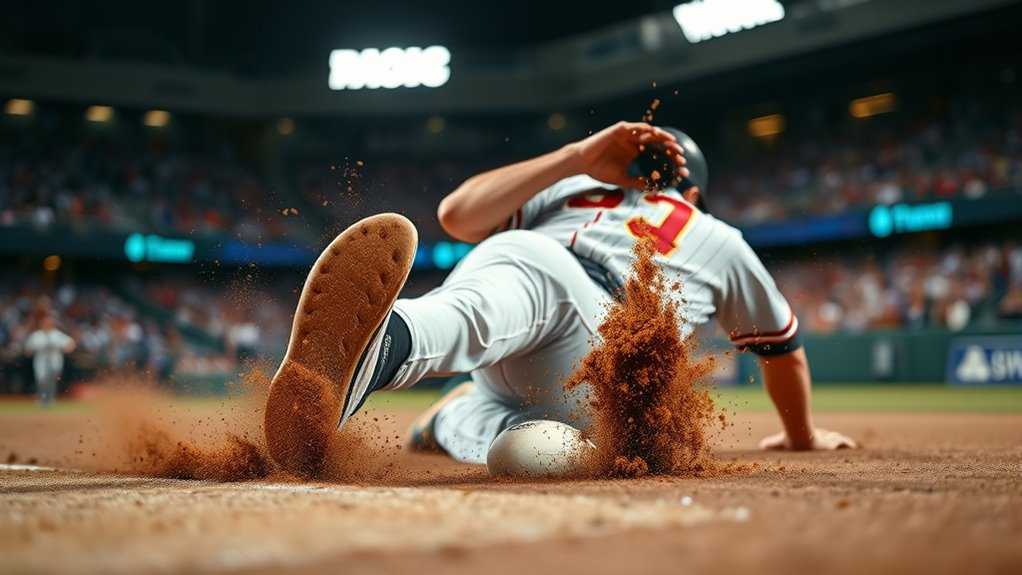
Different types of slides serve specific purposes and can give you an advantage depending on the situation. Knowing the right slide types and their ideal slide timing helps you reach the base safely and quickly. The most common slide types are the feet-first and head-first slides. Use a feet-first slide when you need control and want to avoid injury, especially on a close play. Head-first slides are faster and better for stealing bases or diving into a bag. Timing is essential—slide too early and you might get called out, slide too late and you risk missing the base. Practice recognizing when to use each slide type and perfect your slide timing to maximize your chances of taking the extra base safely. Exploring eco-friendly crafting techniques can also inspire creative ways to make your own sports memorabilia or training accessories using sustainable materials.
Proper Body Position and Timing for Effective Slides
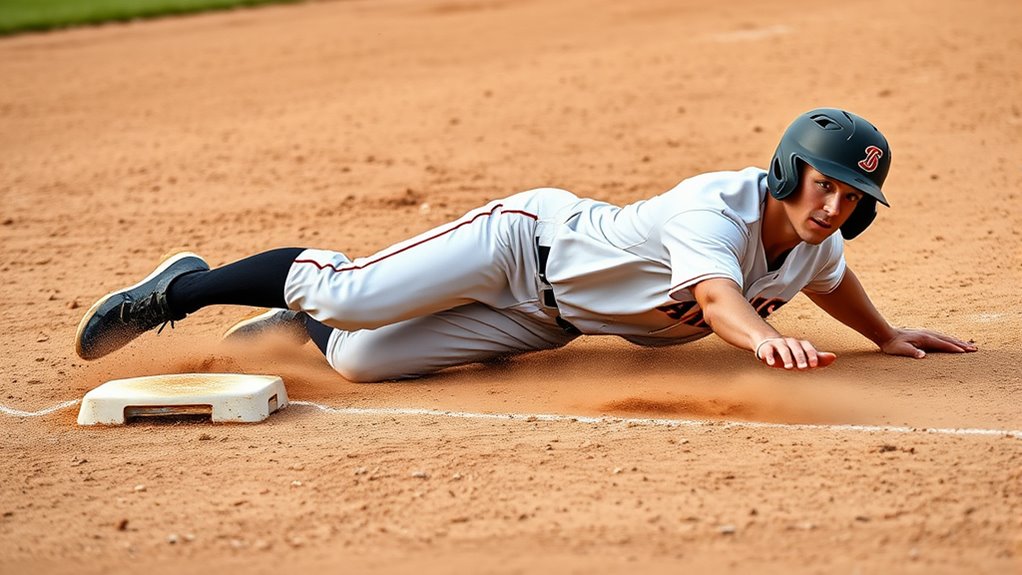
To slide effectively, you need to focus on maintaining proper body position and timing your slide correctly. Good body control helps you stay safe and avoid injuries, while precise timing ensures you reach the base smoothly. Your body should be angled slightly, with your lead shoulder pointed toward the target base. Keep your hands close to your body for quick movement and slide just before the baseman’s tag. Use this table to remember your key points:
| Body Position | Timing | Slide Safety |
|---|---|---|
| Slight angle | Just before tag | Stay low and controlled |
| Hands ready | When the ball is near | Protect your head |
| Feet positioned | As you commit | Avoid dangerous slides |
Mastering these elements improves your slide effectiveness and keeps you safe. Additionally, body control is essential for maintaining proper form and preventing injuries during slides.
Common Mistakes to Avoid During Sliding
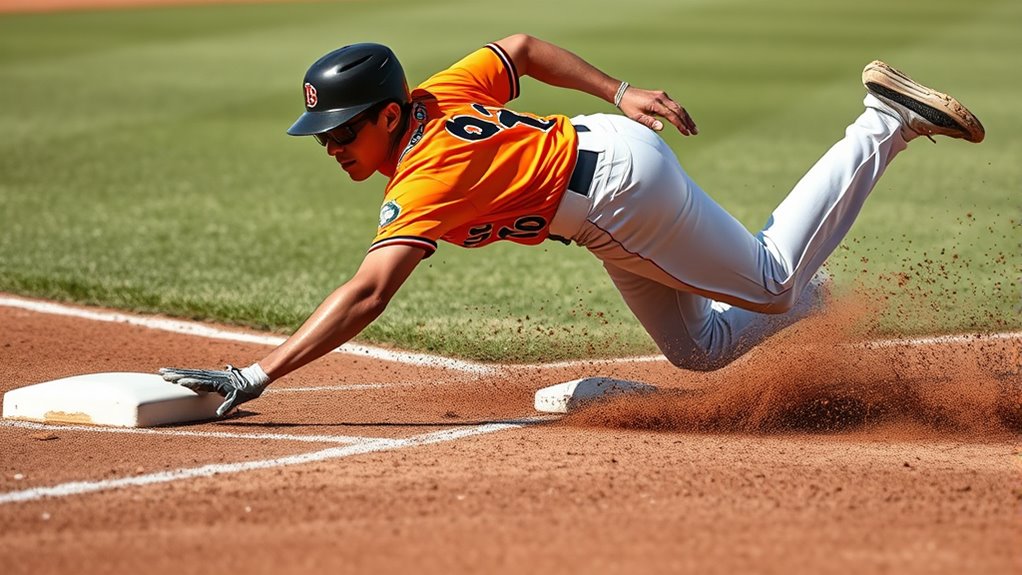
One common mistake players make during sliding is failing to control their body, which can lead to injuries or missed bases. Improper technique often results in players lunging or sliding too late, making it harder to reach the base safely. Poor timing can cause you to slide too early or too late, risking injury or being called out. Avoid rushing your slide or misjudging the pitch’s timing, as this can throw off your entire attempt. Instead, focus on starting your slide at the right moment and maintaining control to stay low and compact. This focus on proper technique helps prevent injuries like collisions or rolled ankles. Remember, a well-timed and controlled slide increases your chances of reaching the base safely while reducing the risk of mistakes.
Tips to Improve Your Base Running and Sliding Skills
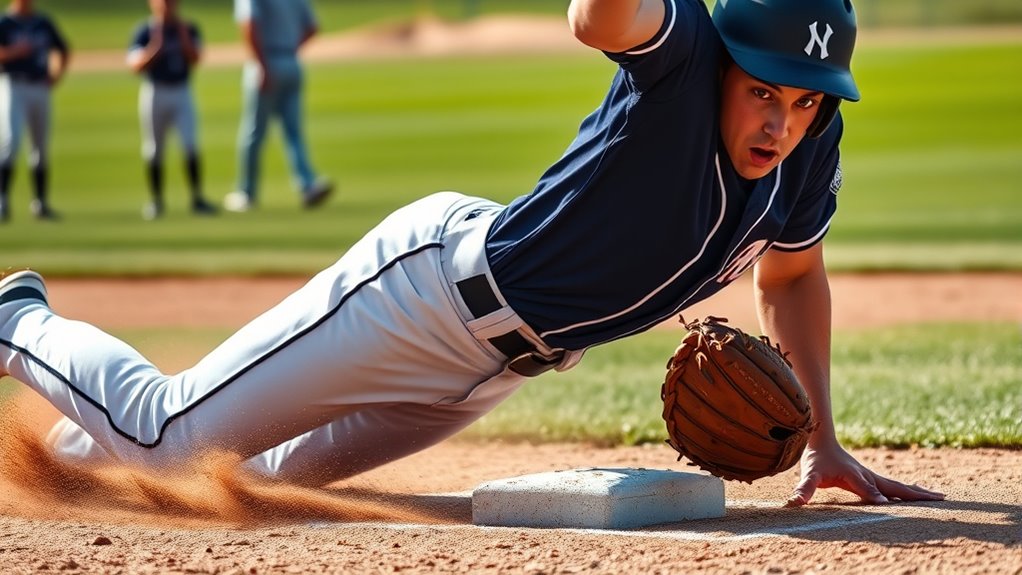
Improving your base running and sliding skills starts with practice and awareness of proper technique. To succeed in base stealing, work on your timing and get comfortable reading the pitcher’s moves. Practice taking efficient lead offs, staying alert to the pitcher’s patterns and cues. When stealing, focus on quick, explosive jumps and a strong push off your back foot. For sliding, work on your technique to avoid injuries and stay in control. Always slide headfirst or feet first depending on the situation, but aim for a smooth, controlled motion. Developing these skills takes repetition and focus, so practice regularly. Stay aware of the game situation, and use smart leads and well-timed steals to take extra bases safely and effectively. Incorporating cultural and regional breakfast traditions can also boost your energy and focus during games.
Frequently Asked Questions
How Can I Improve My Reaction Time During a Slide?
To improve your reaction time during a slide, focus on refining your slide technique through consistent practice. Incorporate reaction drills into your training to sharpen your reflexes and decision-making. Visualize different scenarios and practice reacting quickly to each. Stay alert and prepared, so when the moment comes, you can execute a smooth, effective slide. Over time, these strategies will help you react faster and slide more effectively in game situations.
What Equipment Is Best for Safe Sliding?
Imagine sliding like a skilled surfer catching a wave. To stay safe, you need the right equipment, like slide pads that act as your protective surfboard. These pads, combined with proper sliding techniques, reduce the risk of injury and help you glide smoothly. Invest in high-quality slide pads and master your sliding form to stay safe and confident on the base path, just like a pro catching the perfect wave.
How Do Weather Conditions Affect Sliding Techniques?
Weather conditions substantially impact your sliding technique. On wet or muddy surfaces, you need to adjust your slide speed to avoid slipping or losing control. The sliding surface becomes slick, making a faster slide riskier. To stay safe, slow down and focus on controlling your slide. Proper footwear and awareness of the surface help you adapt, ensuring your slide remains effective without compromising safety.
Are There Age-Specific Sliding Strategies for Young or Older Players?
You should use age-appropriate techniques for sliding, depending on whether you’re a young or older player. Younger players benefit from gentle, controlled slides to prevent injuries, while older players might focus on more advanced techniques to maximize efficiency. Always wear proper sliding safety gear to protect against falls. Adjust your style based on your experience, ensuring safety and effectiveness on the base path.
How Do I Recover Quickly After a Poor Slide Attempt?
Like a true ninja, you can recover quickly after a poor slide by staying calm and using proper slide technique. Focus on your momentum and avoid panicking. Do some sliding drills to build confidence and muscle memory. Roll onto your side, push yourself up smoothly, and get ready for the next play. Remember, even Babe Ruth struck out, but he kept swinging. Keep practicing, and you’ll improve each time.
Conclusion
Mastering smart sliding techniques can boost your chances of taking that extra base safely. Remember, players who slide effectively are 30% more likely to advance safely than those who don’t, according to recent stats. Focus on proper timing, body positioning, and knowing when to slide. By avoiding common mistakes and practicing these tips, you’ll become a smarter, more confident base runner. Elevate your game today and take advantage of every opportunity on the bases!
